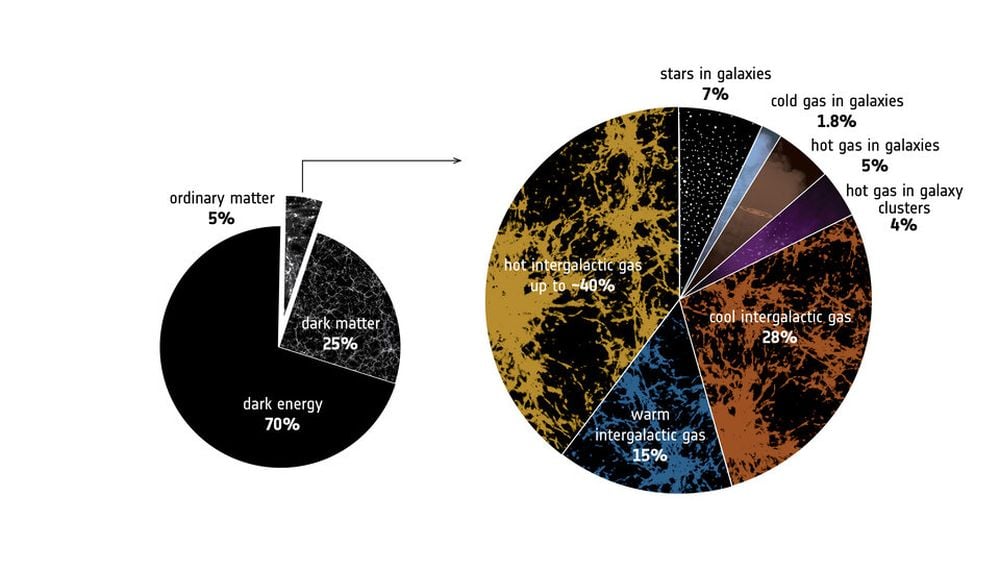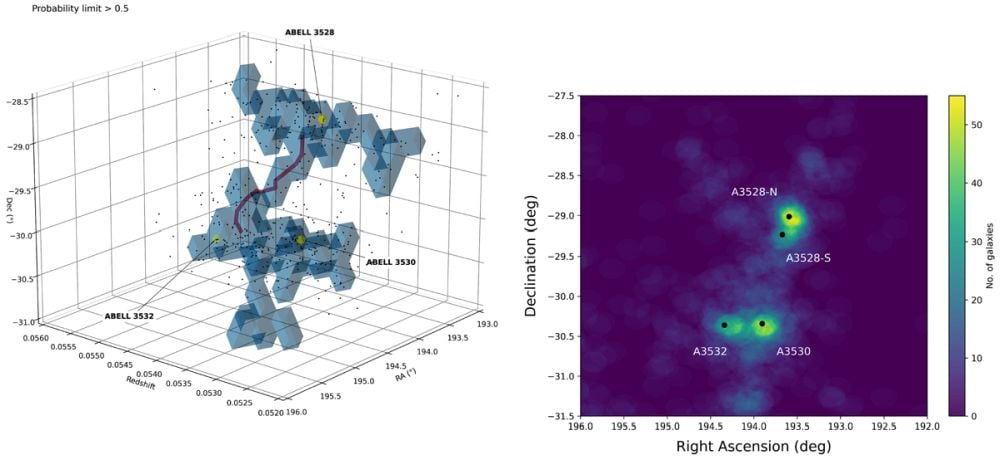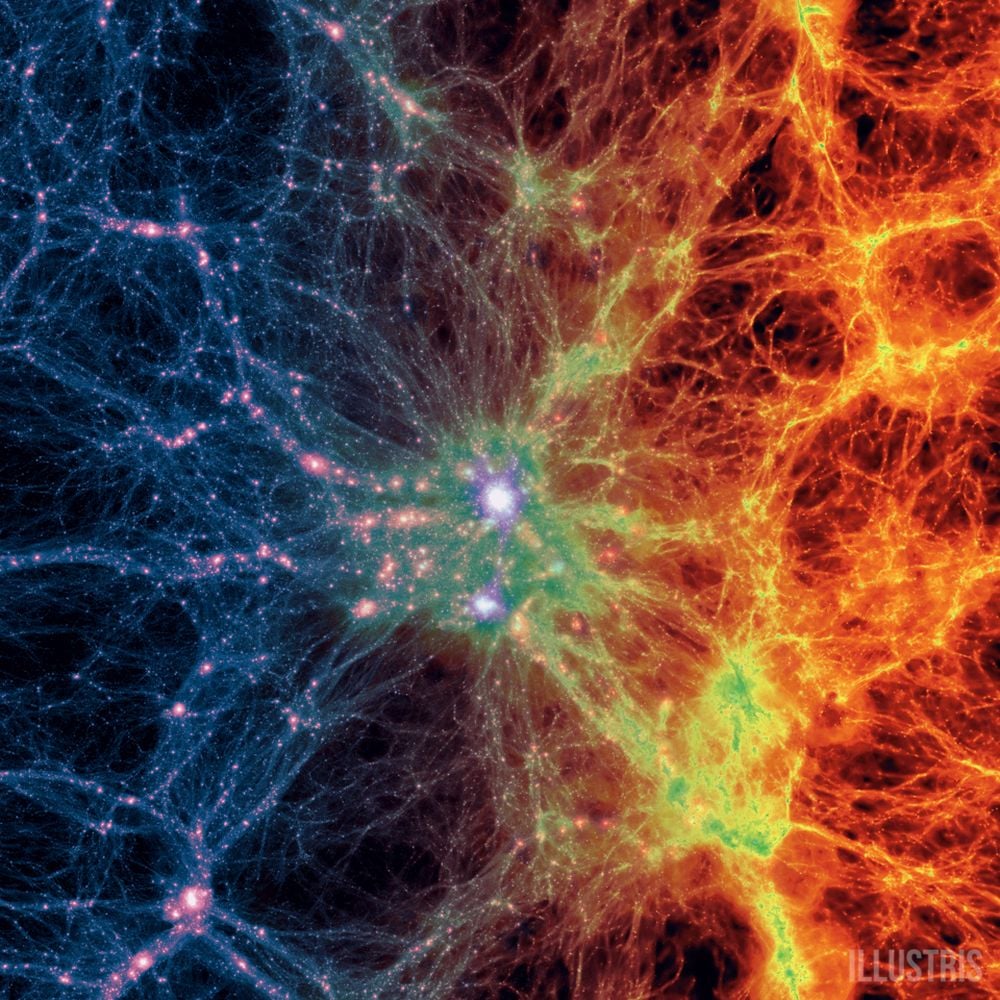Regular matter is properly called baryonic matter. It's made of baryons, which are mostly protons and neutrons (but not electrons). Baryons make up the matter we interact with in everyday life, including our own bodies. Baryonic matter makes up about 5% of the Universe, while dark matter (27%) and dark energy (68%) make up the rest, according to the standard cosmological model, Lambda CDM.
However, some of the Universe's baryonic matter has been missing, or unaccounted for. About one-third of it is undetected, and Lambda-CDM only works if it exists. Since Lambda CDM so accurately predicts many other things about the Universe, scientists have been searching for the missing matter in earnest. Finding it will strengthen the Lambda CDM model.
It looks like they've finally succeeded.
 The warm-hot intergalactic gas, also called the warm-hot intergalactic medium(shown in mottled black-yellow), is a type of ‘ordinary matter’ that astronomers have struggled to find. Image Credit: ESA. ESA Standard License.
The warm-hot intergalactic gas, also called the warm-hot intergalactic medium(shown in mottled black-yellow), is a type of ‘ordinary matter’ that astronomers have struggled to find. Image Credit: ESA. ESA Standard License.
Cosmological models predict that the missing matter can be found in long filaments that extend between matter densities. Astronomers have spotted these filaments, but not with clarity. They're difficult to differentiate from the background because the matter exists as warm intergalactic gas called the warm-hot intergalactic medium (WHIM).
The WHIM can reach extreme temperatures, up to 10 million degrees. At that temperature, the gas emits x-rays. But detecting it is not a simple matter of pointing an x-ray telescope at it because other things emit x-rays, too.
In new research in Astronomy and Astrophysics, researchers explained how they found a filament of the missing matter by using two x-ray telescopes. It's titled "Detection of pure warm-hot intergalactic medium emission from a 7.2 Mpc long filament in the Shapley supercluster using X-ray spectroscopy." The lead author is Konstantinos Migkas of Leiden Observatory in the Netherlands.
"Cosmological simulations indicate that most of the missing baryons reside in cosmic filaments in the form of warm-hot intergalactic medium (WHIM)," the researchers write. "The latter shows low surface brightness and soft X-ray emission, making it challenging to detect." X-ray emissions from these filaments have been detected before, but only a small number of individual filaments. Even fewer yet have been analyzed spectroscopically.
To make progress identifying the missing matter in these filaments, the team used two x-ray telescopes with different properties: the Japanese Suzaku satellite and the ESA's XMM-Newton satellite.
The work focuses on a filament in the Shapley supercluster. The supercluster is 650 million light-years away and is the most massive concentration of galaxies in the Universe that are in a gravitational unit. It's mass is difficult to measure accurately, but some estimates say it contains ten million billion solar masses. Two of its members are the galaxy cluster pairs A3530/32 and A3528-N/S. A filament connecting both pairs is at the subject of this research.
The filament itself is not readily isolated from the background. While it emits x-rays, so do other sources in the area like supermassive black holes. The trick is differentiating between them.
The researchers started by pointing Suzaku at the filament to map its x-rays over a wide region. Then they used XMM-Newton, which has much better angular resolution, to identify supermassive black holes and their x-ray emissions. That allowed them to isolate the filament itself.
But before they could analyze the filament properly, they needed to characterize the surface brightness, gas density, and temperature profiles of the four galaxy clusters. That was the only way to differentiate their signal from the x-ray emissions and other gas properties of the filament itself. The first step was determining where the cluster centers were.
 This figure shows the 3D (left) and 2D (right) galaxy overdensity throughout the filament based on the spectroscopic optical data. In the left panel, spectroscopic galaxies and cluster centers are shown as black and yellow large dots respectively. The filament's central spine is shown in red. Identifying the spine is critical to estimating the filament's geometry and length. In the right panel, the black dots show the X-ray cluster centers. Image Credit: Migkas et al. 2025. Astronomy and Astrophysics.
This figure shows the 3D (left) and 2D (right) galaxy overdensity throughout the filament based on the spectroscopic optical data. In the left panel, spectroscopic galaxies and cluster centers are shown as black and yellow large dots respectively. The filament's central spine is shown in red. Identifying the spine is critical to estimating the filament's geometry and length. In the right panel, the black dots show the X-ray cluster centers. Image Credit: Migkas et al. 2025. Astronomy and Astrophysics.
“Thanks to XMM-Newton we could identify and remove these cosmic contaminants, so we knew we were looking at the gas in the filament and nothing else,” said study co-author Florian Pacaud of the University of Bonn, Germany. “Our approach was really successful, and reveals that the filament is exactly as we’d expect from our best large-scale simulations of the Universe,” Pacaud said in a press release.
They determined that the filament is 7.2 Megaparsecs long, or about 23.5 million light years. Though that's an extreme length, it's classified as a short filament.
Spectral analysis allowed them to detect emissions from the WHIM in two separate regions of the filament, measuring both the temperature and the gas density. They were able to calculate the mass of the filament and its overdensity. Its about 10 times more massive than the Milky Way.
"Our findings agree well with the thermodynamic properties of filaments as predicted by cosmological simulations of the large-scale structure," the authors write.
 The cosmic web consists of filaments of gas connecting galaxy clusters. Image Credit: Illustris TNG/ESA.
The cosmic web consists of filaments of gas connecting galaxy clusters. Image Credit: Illustris TNG/ESA.
“For the first time, our results closely match what we see in our leading model of the cosmos – something that’s not happened before,” said lead researcher Konstantinos Migkas of Leiden Observatory in the Netherlands. “It seems that the simulations were right all along.”
"Our detailed methodology for effectively removing contamination from AGN emission allowed us to trace the WHIM emission that purely originates from the pristine filament we studied, while previous studies might have been more affected by residual emission from halos and point sources," the authors write in their conclusion. By combining Suzaku data with XMM-Newton observations, the researchers "obtained a robust characterization of the WHIM."
“This research is a great example of collaboration between telescopes, and creates a new benchmark for how to spot the light coming from the faint filaments of the cosmic web,” said Norbert Schartel, ESA XMM-Newton Project Scientist. “More fundamentally, it reinforces our standard model of the cosmos and validates decades of simulations: it seems that the ‘missing’ matter may truly be lurking in hard-to-see threads woven across the Universe.”

